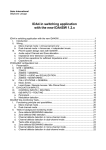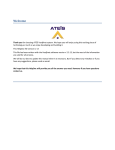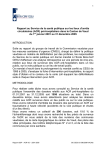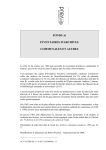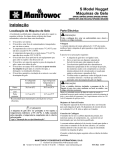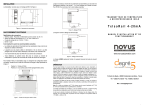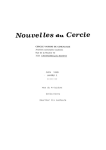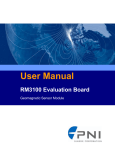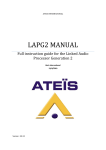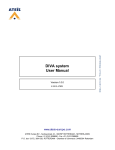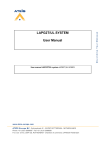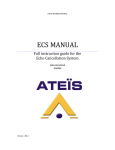Download IDA 4 XM V 1.X
Transcript
IDA 4 XM V 1.X Installation and configuration of IDA 4 XM User Manual IMPORTANT SAFETY INSTRUCTIONS - Switch the device’s power off before any maintenance operation (changing the CU card, etc.) - The 24V power supply voltage should be between 20V and 28V. - The maximum admissible wattage per amplifier channel is 500W effective power. Customer Support ATEIS-INTERNATIONAL S.A Les Charbonnières 1376 Goumoens-La-Ville Switzerland +41 21 881 25 10 +41 21 881 25 09 E MAIL : [email protected] ida4xm_user_manual_v1.x_141204 Page 2 of 49 CONTENTS 1 SOFTWARE_______________________________________________________________________ 4 1.1 PRESENTATION______________________________________________________________ 4 1.2 MAIN ________________________________________________________________________ 5 1.3 SETTINGS ___________________________________________________________________ 7 1.3.1 Application ________________________________________________________________ 7 1.3.2 Site ______________________________________________________________________ 9 1.3.3 Zones____________________________________________________________________ 11 1.3.4 Call stations & messages ____________________________________________________ 16 1.3.5 Evacuation inputs __________________________________________________________ 29 1.3.6 Control inputs _____________________________________________________________ 31 1.3.7 Sources (0dB inputs)________________________________________________________ 34 1.3.8 Serial ports _______________________________________________________________ 39 1.3.9 Fault inputs _______________________________________________________________ 42 1.4 FAULT DESCRIPTION _______________________________________________________ 43 1.4.1 Fault type ________________________________________________________________ 43 1.4.2 Fault consequences _________________________________________________________ 43 1.5 2 MONITORING_______________________________________________________________ 45 HARDWARE _____________________________________________________________________ 46 2.1 REAR PANEL CONNECTIONS ________________________________________________ 46 2.2 BASE WIRING DIAGRAM ____________________________________________________ 47 2.3 MASTER – SLAVE WIRING DIAGRAM ________________________________________ 48 2.4 PC – IDA WIRING DIAGRAM _________________________________________________ 49 2.5 TECHNICAL FEATURES _____________________________________________________ 49 ida4xm_user_manual_v1.x_141204 Page 3 of 49 1 SOFTWARE 1.1 PRESENTATION The PCIDA4XM software is composed of three windows : 1.1 Main for general settings Communication Appearance IDA updating (date and time, internal software) Language 1.2 Settings for application settings (site, zones, call stations, messages,…) Site Zones Call stations and messages Evacuation inputs Control inputs Sources (0dB inputs) Serial ports Fault inputs 1.3 Monitoring for the selection of signal which has to be routed to the monitoring loudspeaker (8 ohms). ida4xm_user_manual_v1.x_141204 Page 4 of 49 1.2 MAIN Serial port Windows Language Serial port The roll list Serial port enables the choice of the serial port on which the communication between the PC and IDA has to be established. In case of failure, for example the selected port is not configured in the PC, the corresponding list item indicates COM X : HS. Otherwise, it indicates COM X : OK. Connection By clicking on the check button Connection, the PC tries to communicate with the connected IDA. In case of success of the connection between the PC and IDA, the check button Connection indicates the following message : Connected to IDA V1.X. In case of failure of the connection between the PC and IDA, the message box NO IDA ! appears on the screen and the check button indicates Not connected. Windows The command button Windows saves the current position of the different windows on the screen. ida4xm_user_manual_v1.x_141204 Page 5 of 49 By new start of the PCIDA4XM software, the windows will appear on the screen as saved by the last click on the command button Windows. Set Date/Time The command button Set Date/Time enables the updating of date and time in IDA. The source can be either the PC or an external clock. By clicking on the command button Date & Time, the message box Date and time updating by PC ? appears on the screen. By clicking on the button OK, the date and time is sent by the PC on IDA. By clicking on the button Cancel, a new message box Date and time updating by an external clock ? appears on the screen. By clicking on the button OK, a date and time updating request is sent to the external clock. IDA Updating The command button IDA Updating enables the updating of the IDA firmware. To update IDA, the following procedure has to be done : • • • • Connect IDA master with all IDA slaves (if IDA slaves are present) Switch on power on IDA The displayed IDA’s number must match with the real IDA’s number Click on the command button IDA Updating to update IDA master and slaves All the IDA will be updated. Language The roll list Language enables the choice of the language. You will have to restart the software to have the new language activated. ida4xm_user_manual_v1.x_141204 Page 6 of 49 1.3 SETTINGS 1.3.1 Application Items Number of IDA Items The roll list Items enables the choice of the item which has to be configured. All options of each item are defined in the following parts. Number of IDA The roll list Number of IDA defines the number of IDA which are present in the current application. Up to 64 IDA can be configured in the application. When you start to set up, the first thing to do is to select the number of IDA cascaded in the system (including the master). Read The command button Read reads the settings saved in IDA’s memory and displays the dataset on the screen. ida4xm_user_manual_v1.x_141204 Page 7 of 49 Write The command button Write loads in IDA’s memory the current dataset which is corresponding to the settings displayed on the screen. You have to write the configuration in the IDA system to activate it. Restart The command button Restart resets the program in IDA. Import The command button Import reads the settings saved in the selected file stored in the PC and displays the dataset on the screen. Export The command button Export saves in the selected PC file the current dataset which is corresponding to the settings displayed on the screen. ida4xm_user_manual_v1.x_141204 Page 8 of 49 1.3.2 Site SITE > GENERAL Name The text box Name defines the name of the application. The maximal length of the application name is 16 alphanumerical characters. Password The text box Password defines the password of the application. The maximal length of the password is 8 numerical characters. Music The roll list Music enables the music start or stop. • • • Change… Music mode can be changed through the call stations Music ON Starting music Music OFF Stopping music ida4xm_user_manual_v1.x_141204 Page 9 of 49 Fault display The check button Fault display enables the display of faults on call stations. Complete log The check button Complete log selects the events which are saved in the log memory. If Complete log is enable, all events are saved in the log memory. Otherwise, only security events are saved. Reduced level The slider Reduced level adjusts the level in reduced mode. The adjustment can be defined between –12 and 0 dB. Loud level The slider Loud level adjusts the level in loud mode. The adjustment can be defined between 0 and +12 dB. Level change The roll list Level change defines the general level of the application. • • • • Change… Reduced Loud Normal General level can be changed on call stations General level is reduced to the adjusted level General level is increased to the loud level General level is set to the normal level The check button Automatic enables the automatic change of level. Text boxes Normal and Reduced define the timetables for the change. • • Normal Reduced Level changes from reduced to normal Level changes from normal to reduced ida4xm_user_manual_v1.x_141204 Page 10 of 49 1.3.3 Zones Four zones can be configured on each IDA. ZONES > GENERAL Name The text box Name defines the name of the zone. The maximal length of the application name is 11 alphanumerical characters. ida4xm_user_manual_v1.x_141204 Page 11 of 49 ZONES > AUDIO Music level The slider Music level adjusts the normal music level in the selected zone. The adjustment can be defined between –70 and +12 dB. Music signal is OFF if the Music level slider is put on its bottom end. Call level The slider Call level adjusts the normal call level in the selected zone. The adjustment can be defined between –70 and +12 dB. Call signal is OFF if the Call level slider is put on its bottom end. Delay The slider Delay adjusts the delay in the selected zone. The adjustment can be defined between 0 and 682 ms. ida4xm_user_manual_v1.x_141204 Page 12 of 49 ZONES > EQUALIZATION Parametric equalization The output audio signal of each zone can be adjusted with a 7-bands equalizer. The slider F defines the frequency between 20 and 19 000 Hz. The slider Q defines the Q parameter (which is corresponding to the bandwidth) between 1/3 and 12. The slider G defines the output level of the corresponding band between –12 and +12 dB. Copy / Paste The command buttons Copy and Paste enable the copy of one band settings in other bands. ida4xm_user_manual_v1.x_141204 Page 13 of 49 ZONES > MONITORING Zone references The command button Zone references measures the following parameters of the selected zone (1k and 18k impedance, 18k gain and open gain, leak) and stores the values in IDA’s memory. All zones references The command button All zones references measures the following parameters of all the zones (1k and 18k impedance, 18k gain and open gain, leak) and stores the values in IDA’s memory. Zone Z1k test The command button Zone Z1k test measures once the 1k impedance of the selected zone. All zones Z1k test The command button All zones Z1k test measures once the 1k impedance of all the zones. If the check button Auto is selected, the 1k impedance measurement is done at the defined time (03:00 by default). ida4xm_user_manual_v1.x_141204 Page 14 of 49 Measures display If the check button Display is selected, the values of the parameters measures corresponding to the selected zone are displayed in real-time. Backup amplifiers The roll list Backup amplifiers specifies the presence or not of amplifiers on the application. Monitoring The option buttons Monitoring defines which components have to be controlled in the selected zone : • • • • • No monitoring Amplifier Amplifier + Line Amplifier + Backup amplifier Amplifier + Backup amplifier+ Line ida4xm_user_manual_v1.x_141204 Page 15 of 49 1.3.4 Call stations & messages CALL STATIONS > GENERAL Routing Touch setting setting Page setting Name The text box Name defines the name of the call station. The maximal length of the call station name is 11 alphanumerical characters. Password The text box Password specifies the password which is required to use the PSS call station. The password must be composed of 4 numerical characters. Page setting The command button Put allocates a page to the selected page in the call station pages list. Up to 32 pages can be defined. The command button New selects the first page which is not allocated to a call station. The command button Delete deletes the page allocation for the selected page in the call station pages list. ida4xm_user_manual_v1.x_141204 Page 16 of 49 Key setting To define a key on a selected page, the following procedure has to be done : • • • • Select a page either with the page slider or with the command button New Click on the key to define Select the type of the key in the type roll list (Local zones, Telesonorisation, Reduced level, Loud level, Music ON) Enter the key name in the key picture The command button Delete deletes the selected key settings. The command button Name copy copies only the name of the selected key. The command button Copy copies all the settings of the selected key. The command button Paste pastes in the selected key either the name which was first copied through the command button Name copy or all the settings which were first copied through the command button Copy. ida4xm_user_manual_v1.x_141204 Page 17 of 49 CALL STATIONS > AUDIO Microphone level The slider Level adjusts the call station microphone level. The adjustment can be defined between –70 and +12 dB. Microphone signal is OFF if the Level slider is put on its bottom end. Speaker level The slider Speaker adjusts the PSS speaker level. The adjustment can be defined between –70 and +6 dB. Speaker signal is OFF if the Speaker slider is put on its bottom end. ida4xm_user_manual_v1.x_141204 Page 18 of 49 CALL STATIONS > EQUALIZATION Parametric equalization The input audio signal can be adjusted with a 3-bands equalizer. The slider F defines the frequency between 20 and 19 000 Hz. The slider Q defines the Q parameter (which is corresponding to the bandwidth) between 1/3 and 12. The slider G defines the output level of the corresponding band between –12 and +12 dB. Copy / Paste The command buttons Copy and Paste enable the copy of one band settings on other bands. ida4xm_user_manual_v1.x_141204 Page 19 of 49 CALL STATIONS > PRIORITY Priority The priority of the corresponding call station can be adjusted through the slider Priority. It can range from 0 to 100. ida4xm_user_manual_v1.x_141204 Page 20 of 49 CALL STATIONS > MESSAGES Message allocation on call station To allocate a message on a call station, the following procedure has to be done : • • • Select a message in the Messages on station list (up to 4 messages can be set on a PSS, MSGS1 to MSGS4) Select the corresponding message in the Messages list (up to 32 messages can be configured in an application) Click on the command button < to allocate the message Message deletion on call station To delete a message on a call station, the following procedure has to be done : • • Select an allocated message in the Messages on station list Click on the command button Delete Buzzer ON The check button Buzzer ON enables the call station buzzer in case of fault. ida4xm_user_manual_v1.x_141204 Page 21 of 49 Call station type The check button Security selects the type of call station. Fault reaction The option button Fault reaction selects the kind of fault which appears in case of call station absence. The difference between immediate and deferred fault is described on section 1.4 Fault description. ida4xm_user_manual_v1.x_141204 Page 22 of 49 MESSAGES > GENERAL Name The text box Name defines the name of the message. The maximal length of the message name is 11 alphanumerical characters. Type The roll list Type defines the type of message : Evacuation or Normal. Siren length The slider Siren length adjusts the length of the siren before the message diffusion. The adjustment can be defined between 0 and 255 seconds. Delete message The command button Delete message deletes the selected message if stored in IDA’s memory. ida4xm_user_manual_v1.x_141204 Page 23 of 49 Delete all messages The command button Delete all messages deletes all the messages which are stored in IDA’s memory. Send message The command button Send message saves in IDA’s memory a recorded message stored on PC (*.wav format). The sampling of messages must be 16 bits 16kHz. The maximal length including all messages is 2 minutes and 11 seconds. Message recording through 0dB input is not allowed on IDA4XM. ida4xm_user_manual_v1.x_141204 Page 24 of 49 MESSAGES > AUDIO Level The slider Level adjusts the message level for the selected message. The adjustment can be defined between –70 and +12 dB. Message signal is OFF if the Level slider is put on its bottom end. ida4xm_user_manual_v1.x_141204 Page 25 of 49 MESSAGES > EQUALIZATION Parametric equalization The message signal can be adjusted with a 3-bands equalizer. The slider F defines the frequency between 20 and 19 000 Hz. The slider Q defines the Q parameter (which is corresponding to the bandwidth) between 1/3 and 12. The slider G defines the output level of the corresponding band between –12 and +12 dB. Copy / Paste The command buttons Copy and Paste enable the copy of one band settings on other bands. ida4xm_user_manual_v1.x_141204 Page 26 of 49 MESSAGES > PRIORITY Priority The priority level (0 to 100) of the corresponding message can be adjusted through the slider Priority. ida4xm_user_manual_v1.x_141204 Page 27 of 49 MESSAGES > SIREN Siren level The slider Siren level adjusts the siren level for all messages configured with siren. The adjustment can be defined between –71 and +12 dB. Parametric equalization The siren signal can be adjusted with a 3-bands equalizer. The slider F defines the frequency between 20 and 19 000 Hz. The slider Q defines the Q parameter (which is corresponding to the bandwidth) between 1/3 and 12. The slider G defines the output level of the corresponding band between –12 and +12 dB. ida4xm_user_manual_v1.x_141204 Page 28 of 49 1.3.5 Evacuation inputs Four evacuation inputs can be configured on each IDA. Routing Name The text box Name defines the name of the evacuation input. The maximal length of the evacuation input name is 11 alphanumerical characters. Message The roll box Message selects the message which is played back when the corresponding evacuation input is active. Play mode The slider Play mode adjusts the number of times the message is playing back. The adjustment can be defined between 1 and 255 times. Play mode is Looped if the Play mode slider is put on its bottom end. ida4xm_user_manual_v1.x_141204 Page 29 of 49 Routing The zones on which the message is played back can be selected through the check boxes Routing. ida4xm_user_manual_v1.x_141204 Page 30 of 49 1.3.6 Control inputs Four control inputs can be configured on each IDA. CONTROL INPUTS > GENERAL Name The text box Name defines the name of the control input. The maximal length of the control input name is 11 alphanumerical characters. Mode The roll list Mode selects the call playing mode : inactive, call or chime + call. Chime must have been first stored on IDA’s memory. See section 3.4 MESSAGES > GENERAL to send the message “Chime” (wave file). Source allocation on control input To allocate a source (0dB input) to a control input, the following procedure has to be done : • • Select a source in the Available 0dB inputs list Click on the command button < to allocate the message ida4xm_user_manual_v1.x_141204 Page 31 of 49 Source deletion on control input To delete a source on a control input, the following procedure has to be done : • Click on the command button Delete Busy signal When an higher priority message or call is currently played on the zones allocated to the control input, either a relay is commuted on the selected contact output or a 400 Hz tone is played on the selected 0dB output. The roll list Busy signal selects the contact or the 0dB output. Tone must have been first stored on IDA’s memory. See section 3.4 MESSAGES > GENERAL to send the message “Tone” (wave file). ida4xm_user_manual_v1.x_141204 Page 32 of 49 CONTROL INPUTS > ROUTING Routing Routing The check buttons Routing enable the routing of the control input’s allocated source on defined zones. ida4xm_user_manual_v1.x_141204 Page 33 of 49 1.3.7 Sources (0dB inputs) Four 0dB inputs can be configured on each IDA. 0dB INPUTS > GENERAL Name The text box Name defines the name of the 0dB input. The maximal length of the 0dB input name is 11 alphanumerical characters. ida4xm_user_manual_v1.x_141204 Page 34 of 49 0dB INPUTS > AUDIO Level The slider Level adjusts the input level of the selected 0dB input. The adjustment can be defined between –70 and +12 dB. Input signal is OFF if the Level slider is put on its bottom end. ida4xm_user_manual_v1.x_141204 Page 35 of 49 0dB INPUTS > EQUALIZATION Parametric equalization The input audio signal can be adjusted with a 3-bands equalizer. The slider F defines the frequency between 20 and 19 000 Hz. The slider Q defines the Q parameter (which is corresponding to the bandwidth) between 1/3 and 12. The slider G defines the output level of the corresponding band between –12 and +12 dB. Copy / Paste The command buttons Copy and Paste enable the copy of one band settings on other bands. ida4xm_user_manual_v1.x_141204 Page 36 of 49 0dB INPUTS > ROUTING Routing Sources mode The option button Sources mode selects the mode of routing : • • Permanent The source is routed permanently to the fixed zones. Modulation detection (VOX activation) The Source routing is active if the source level exceeds defined threshold. This threshold is adjustable through a slider from 70 to +20 dB. Routing The check buttons Routing enable the routing of the corresponding source on defined zones. ida4xm_user_manual_v1.x_141204 Page 37 of 49 0dB INPUTS > PRIORITY Priority The priority of the corresponding source can be adjusted through the slider Priority. In permanent mode, the priority can’t be adjusted and is set to Low. ida4xm_user_manual_v1.x_141204 Page 38 of 49 1.3.8 Serial ports Two serial ports can be configured on each IDA. SERIAL PORTS > SERIAL PORTS Settings All serial port parameters can be set through the several roll lists Protocol, Baud rate, Parity, Stop and Data bits. Source allocation on channel To allocate a source (0dB input) to a channel, the following procedure has to be done : • • • Select a source in the Available 0dB inputs list Select the corresponding channel in the Audio channels list Click on the command button < Put to allocate the source ida4xm_user_manual_v1.x_141204 Page 39 of 49 Source deletion on channel To delete a source on a channel, the following procedure has to be done : • • Select a channel in the Audio channels list Click on the command button Delete ida4xm_user_manual_v1.x_141204 Page 40 of 49 SERIAL PORTS > ZONES ALLOCATION CODES Routing Codes Codes correspond to selected zones on which the channel must be routed. To allocate zones on codes, the following procedure has to be done : • • Select a code in the Codes list Configure the check buttons Routing Copy The command button Copy copies the allocated zones of the selected code. Paste The command button Paste pastes in the selected code the zone which were first copied through the command button Copy. Delete The command button Delete deletes the allocated zones of the selected code. After a Delete command, the code is empty. ida4xm_user_manual_v1.x_141204 Page 41 of 49 1.3.9 Fault inputs One fault input can be configured on each IDA. Name The text box Name defines the name of the fault input. The maximal length of the fault input name is 11 alphanumerical characters. Faults The roll lists Faults define the kind of fault : • • • Immediate or deferred fault, or inactive Opening or closing (contact normally close or normally open) Security or normal ida4xm_user_manual_v1.x_141204 Page 42 of 49 1.4 FAULT DESCRIPTION 1.4.1 Fault type Immediate faults • • • • • • All call station-related faults Fault inputs if immediate type selected All LS line-related faults (except leakage fault) Power amplifier-related faults if no backup amplifier Power amplifier-related faults if backup amplifier OL No message in memory fault Deferred faults • • • • Power amplifier-related faults if backup amplifier OK Backup amplifier-related faults if all power amplifiers OK LS line earth leakage fault Fault inputs if deferred type selected Security faults • Fault inputs if security type selected 1.4.2 Fault consequences Immediate faults On IDA Master • Yellow LED “Fault” lighted • Fault display on LCD • Remote control outputs open • Immediate fault general relay open • Deferred fault general relay closed On IDA Slave • Yellow LED “Fault” lighted if link with Master disconnected or presence of immediate fault on this unit On call station (if option Fault display on call station selected – see section 1.3.4) • Yellow LED “Fault” blinking • “DEF I” display on the zones (keys) concerned by the immediate fault • Fault display on the screen right bottom • Buzzer on Deferred faults On IDA Master • Fault display on LCD • Deferred fault general relay open • Immediate fault general relay closed ida4xm_user_manual_v1.x_141204 Page 43 of 49 On call station (if option Fault display on call station selected – see section 1.3.4) • Yellow LED “Fault” blinking • “DEF D” display on the zones (keys) concerned by the deferred fault • Fault display on the screen right bottom Security faults Evacuation messages and call stations defined as security call stations are allowed. All other functions are not allowed. Music is switched OFF, calls on not security call stations are not permitted … ida4xm_user_manual_v1.x_141204 Page 44 of 49 1.5 MONITORING Presence signal bar graph Monitoring selection The roll list Monitoring selection enables the selection of the signal which has to be routed to the monitoring loudspeaker (8 ohms). • • • • • • Speaker OFF Loudspeakers lines 0dB outputs 0dB inputs 0db inputs (EQ) Call stations microphones No signal Zone signal after amplification Zone signal before amplification Source signal before equalization Source signal after equalization Call station microphone signal Volume setting The slider adjusts the volume of the signal on the monitoring loudspeaker. Signal presence The presence of signal can be controlled by a bar graph which appears on the top of the window (only if signal is present). ida4xm_user_manual_v1.x_141204 Page 45 of 49 2 HARDWARE 2.1 REAR PANEL CONNECTIONS ida4xm_user_manual_v1.x_141204 Page 46 of 49 2.2 BASE WIRING DIAGRAM ida4xm_user_manual_v1.x_141204 Page 47 of 49 2.3 MASTER – SLAVE WIRING DIAGRAM IDA4XM IDA4XMs 1 IDA4XMs 2 IDA4XMs n IDA4XM(s) n + 1 Rx 12 34 56 78 MASTER - SLAVE CONFIGURATION CABLE 12 34 56 78 IDA4XM(s) n Tx ida4xm_user_manual_v1.x_141204 Page 48 of 49 2.4 PC – IDA WIRING DIAGRAM 2.5 TECHNICAL FEATURES 0 dB inputs / outputs 100 V inputs / outputs Digital audio messages Evacuation / control inputs / outputs Serial connections Size and material Power supply Audio input impedance: 10 kOhms (balanced, screw terminal) Input sensivity: 0 dB Audio output impedance: 50 Ohms (balanced, screw terminal) Output level: 0 dB Max. input / output level: +14 dBv Audio bandwidth: 10 Hz to 22 kHz Sampling: 48 kHz 24 bits Distortion: 0.02 % to 1 kHz Output noise: < -84 dBu Lin, < -88 dBu A-weighted Output dynamic: > 98 dBu Lin, > 102 dBu A-weighted Max. power per channel: 500 W Amplifier gain measurement: 1 kHz, 18 kHz Line impedance measurement: 100 V 1 kHz 18 kHz Bandwidth: 8 kHz Sampling 16 kHz 16 bits 4 messages, total length 2 minutes and 11 seconds 4 evacuation (alarm) inputs (activation 24 – 72 V) 4 contact outputs 1 contact input (main power fault or battery backup fault) 1 contact output (fault synthesis) 1 RS485 connection to PSS microphone 2 RS232 connections to a configuration PC or a message base Metal enclosure 1U 19” grey RAL 7016 L * W * D: 430 * 44 * 230 mm Weight: 3 Kg 24 VDC (power supply 230 VAC / 24 VDC included) 300 mA without PSS microphone, 750 mA with PSS microphone ida4xm_user_manual_v1.x_141204 Page 49 of 49

















































